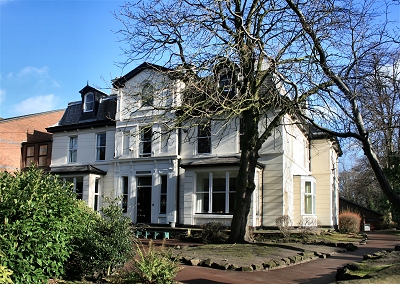 |
| Mossley
Hill Road c.1930 |
 |
| Besford
Grange |
 |
| Linwood |
|
| North Mossley Hill Road |
| The northern part of
Mossley Hill Road was one of the most desirable
areas for wealthy merchants of Victorian times.
In terms of the survival of properties to the
present day, it has fared far better than most of
the area. |
| Starting at the northern
end of Mossley Hill Road and heading south is a
group of five mansions dating from the 1840s, Godwyn,
Lynton and Besford Grange on
the left, and Beechlands and Mossley
Vale House on the right. They have been
subsumed into the present Liverpool College.
Liverpool College moved to its present site in
1929, although several acres in Mossley Hill were
purchased as playing fields in 1896 and the
present pavilion was built in 1905. Further land
and building purchases took place up to 1936. |
| By 1891 and until his
death, Godwyn was the home of Thomas Bellringer
Howarth (1839-1917), a solicitor and Registrar of
Liverpool County Court. By 1891 and until his
death, Lynton was owned by brewer John Adams
Bartlett (1826-1901); his widow Ada Jane was
still living there in 1911. By 1891 Besford
Grange was owned by corn merchant Ernest Woodward
(b.1843). Shipbroker James Frederick Browne
(1842-1913) was living there in 1901 and until
his death. Beechlands was the home of foreign
general merchant Herbert William Rowe (1854-1918)
in 1901. Mossley Vale House was the home of
landowner Alfred Graham (1815-1873) by 1861 and
until his death. Thereafter his widow Anne
Harrison Graham (1822-1902) lived on there for
many years until her death. It was subsequently
acquired by corn merchant Thomas William Right
(1843-1922), who lived there until his death. |
| On the other side of the
present Queens Drive, mansions line both sides of
the road and there are many more along Elmsley
Road, although Elmsley itself has gone.
Back on Mossley Hill Road, notable examples are,
on the right, Wiston House, home in 1901
and until his death of German born Frederick
Ferdinand Conrad Herzog (1847-1929), a general
foreign merchant and exporter. Brucklay House
was owned by South America merchant Hugh Brown
(1839-1911) by 1901 and until his death. Further
along, Linwood (1869) was owned by 1891
and until his death by John Lea (1851-1927), a
coal merchant, who probably acquired it from
shipowner Walter Holland (1843-1915), who moved
to Carnatic Hall in the 1870s. |
| On the left are Elmswood,
built before 1840 for merchant Thomas Sands
(b.1791) and extended in 1878 by the owner,
cotton broker Nicholas Duckworth (1817-1889), and
Clearwood home in 1891 of Mary Fletcher,
probably the widow of banker William Fletcher
(1803-1886). On Carnatic Road, Redcourt was the
home by 1901 and until his death of William
Parkfield Wethered (1864-1917), a chemicals
company director. |
|
 |
| Godwyn |
 |
| Beechlands |
 |
| Elmswood |
|